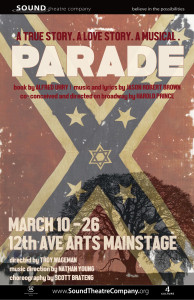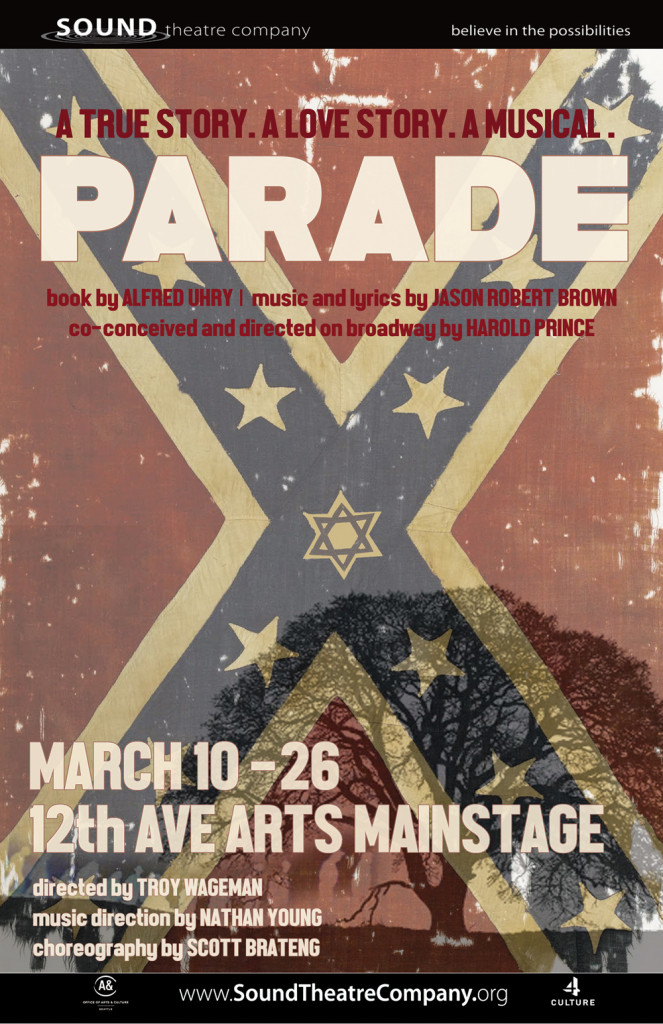 PARADE – Thoughts from the Composer
PARADE – Thoughts from the Composer
For today’s blog, we thought we’d re-print some fabulous thoughts from the Tony Award-winning composer of PARADE. This is taken from the website of Jason Robert Brown (jasonrobertbrown.com, natch) and if you haven’t checked his site out, please do. It’s a fantastic treasure trove of information and insight from one of the sharpest and most talented composers working today.
That’s JASONROBERTBROWN.COM. Check it out.
What follows is excerpted from his blog entry of October 7, 2007, “REVIVAL.”
To compare the ecstatic critical reception of the Donmar production of Parade that just opened to the considerably more reserved response nine years ago, you might think we’d started from scratch and overhauled the entire show. In fact, it’s pretty much the same piece it always was, except for the new happy ending where Leo and Mary tap dance into Heaven together.
I’m kidding, I’m kidding, it’s a samba.
Truly, though, if you only know Parade through the original cast album, you’ll maybe notice two or three changes. For those of you who’ve actually done the show, or have a photographic recall of the time you saw it, the show is really about 80-85% the same, but you’ll notice many of the differences, and I think you’ll agree with me that they’re all for the better. Here’s a basic summary of the changes we made, and why we made them:
1. It used to be an epic, now it’s a chamber piece. If we had done nothing to the show but agreed to let the Donmar cut down the size of the cast and orchestra, that alone would have been a substantial revision. I was hired by Hal Prince to write “an American opera,” and Alfred and Hal and I deliberately made the choice that Parade should be big. We opened at Lincoln Center with a cast of thirty-six and an orchestra of twenty. Because of the size of the Donmar (only 260 seats), there was no way to recreate the size of that production, and so we reduced the cast to fifteen and the orchestra to nine. (Even at those numbers, it’s the biggest show the Donmar have ever done.) Therefore, everything about the show is tighter, sharper, smaller, more aggressive. I’m not sure that always works in the show’s favor, but much of the time it certainly does. Inevitably, the focus of the show changed, and the most obvious respect in which the dynamic shifted is that the only two actors who don’t double or triple other parts are the actors playing Leo and Lucille. Therefore, we recognize them always as “other,” as “different.” Similarly, the importance of other characters diminished because they were being doubled and tripled: the actor who plays Governor Slaton also plays Britt Craig, for example, which makes you watch both of those characters differently. And which led us to…
2. Britt Craig is not the star of the show. When we started working on Parade in 1994, we made an outline that differed in many respects from the final production, not least of which was that Britt Craig, the reporter who broke the Leo Frank story, served as a narrator and the audience’s stand-in. We began writing the show by following the outline, which had a big introductory number for Britt called “Big News.” As we went on writing, Britt became less and less important to the storytelling, but we had given him such a big fabulous introduction that we felt obliged to keep him in the forefront of the narrative. This became particularly problematic in Act Two, where there really was nothing for him to do other than occasionally tell us about the way the rest of the world was reacting to the case. All along, I kept saying that the problem was that we hadn’t given Britt Craig enough to do after such a big introduction. In fact, the problem was the opposite: we shouldn’t have given Britt Craig such a big introduction because he just wasn’t important enough. So when Alfred and I sat down this spring to reassess the show, we decided to just cut “Big News” and let Britt Craig assume his natural tertiary position in the narrative. I’ve watched this production eight or nine times, and I’ve never missed it. Luckily, the song is preserved (with Evan Pappas’s marvelous performance and a truly awesome orchestration) on the original cast album.
NOTE FROM RENEGADE: Jason Robert Brown and MTI have included “Big News” in the script, as an optional scene and song. Our production will include this scene and number, because we really, really love it.
3. Dorsey needed some help in Act Two. I always loved Act One because it set up such a grand panorama of characters and swung them into motion in what I thought was a very elegant way, but I felt like Act Two focused so tightly on Leo and Lucille that we lost some of that panorama. (Audiences seemed to respond exactly the opposite way: they’d seem confused and overwhelmed throughout the first act, but sit riveted and engaged during the second.) As we trimmed down the show and tried to draw straighter lines for each of the characters, we realized that we did a great job in Act One of setting up Hugh Dorsey, the district attorney, but he disappeared in Act Two, and we missed him. Furthermore, we had a whole song given to Judge Roan, a character who nobody cared about and most people probably didn’t recognize. So we converted “Letter to the Governor” into an entirely new piece that would point up Dorsey’s political ambition and explain the undercurrent of fury that blows up during “Where Will You Stand When The Flood Comes?”. It’s now a great duet for the Judge and Dorsey called “The Glory.” In order to write the song, however, Alfred and I did have to change a bit of history (not for the first time in the creation of this piece): according to the books, Judge Roan did in fact write a letter on his deathbed to the Governor questioning the Frank verdict, and that letter convinced Slaton to re-open the case. According to our show in this new version, the Judge thinks it’s a mistake for Slaton to get mixed up in the Frank business, and he grooms Dorsey as a potential successor.
4. Goodbye Newt, Hello Minnie. All that doubling and tripling of characters had some wonderful effects on the play, but sometimes it worked against us. We had only one actor (the wonderful Shaun Escoffery) playing the three black men in the show, Jim Conley, Newt Lee and Riley, the Governor’s driver. What we discovered during the first readthrough was that Jim Conley overwhelmed everything else: when Shaun had to switch from Conley back to Newt, it was always a letdown for the audience to watch this actor subdue all of the charisma we’d just seen. At the same time, we were severely underutilizing an enormous asset: Malinda Parris, who plays the role of Angela, maid to the Slatons. Angela really only exists to sing “A Rumblin’ and a Rollin’”, but it was obvious Malinda could do much more than we were asking of her. So Alfred and I decided it was finally time to let Minnie McKnight take the stage. Minnie was the domestic who worked for Leo and Lucille Frank, and she had an interesting part in the case (she was coerced into signing an affadavit that was certainly partially responsible for Leo’s indictment); we also enjoyed the dynamics that would come from having an intimate member of the household testify against Leo. So we replaced all of Newt’s testimony in the trial and his reprise in Act Two with a new piece for Minnie McKnight. And now we love having Minnie in the show – I can’t imagine that she wasn’t there all along.
5. Fiddlin’ John, we hardly knew ye. Fiddlin’ John Carson is considered by some to be the first “country music” performer, but he’s important to the Leo Frank story because he wrote a song called “The Ballad of Little Mary Phagan” (you can listen to Moonshine Kate, his daughter, in her recording of the song here, but I’ll be amazed if you make it through more than a minute or so) which he performed on the steps of the courthouse as Leo was sentenced to death. People sang it for years afterward, and Southerners of a certain generation still remember Fiddlin’ John. However, as far as Parade was concerned, he was just one more goddamn person for the audience to keep track of, and so we decided that time could be better spent on a character who actually mattered to the plot: Tom Watson. So I wrote a new song called “Hammer Of Justice” for Watson to sing at the start of the trial, which replaces “People of Atlanta” and all of its reprises. It’s a really cool song, too.
6. The top of the second act. Again. Britt Craig’s pretty much out of the picture, so we couldn’t start the act with him. Instead, Alfred wrote a lovely scene for Governor Slaton and his wife Sallie which sets them up as important people to watch in Act Two, and I underscored the scene with an a cappella chorale led by Tom Watson. Then the servants come in to clean up the Slatons’ breakfast, and they go right into “A Rumblin’ and a Rollin’.” (We had to change that song a bit because it’s now a duet instead of a quartet.) All told, it’s the first time we’ve all been happy with the way the second act starts. Which is good, because we’re not revising this fucking show anymore.
